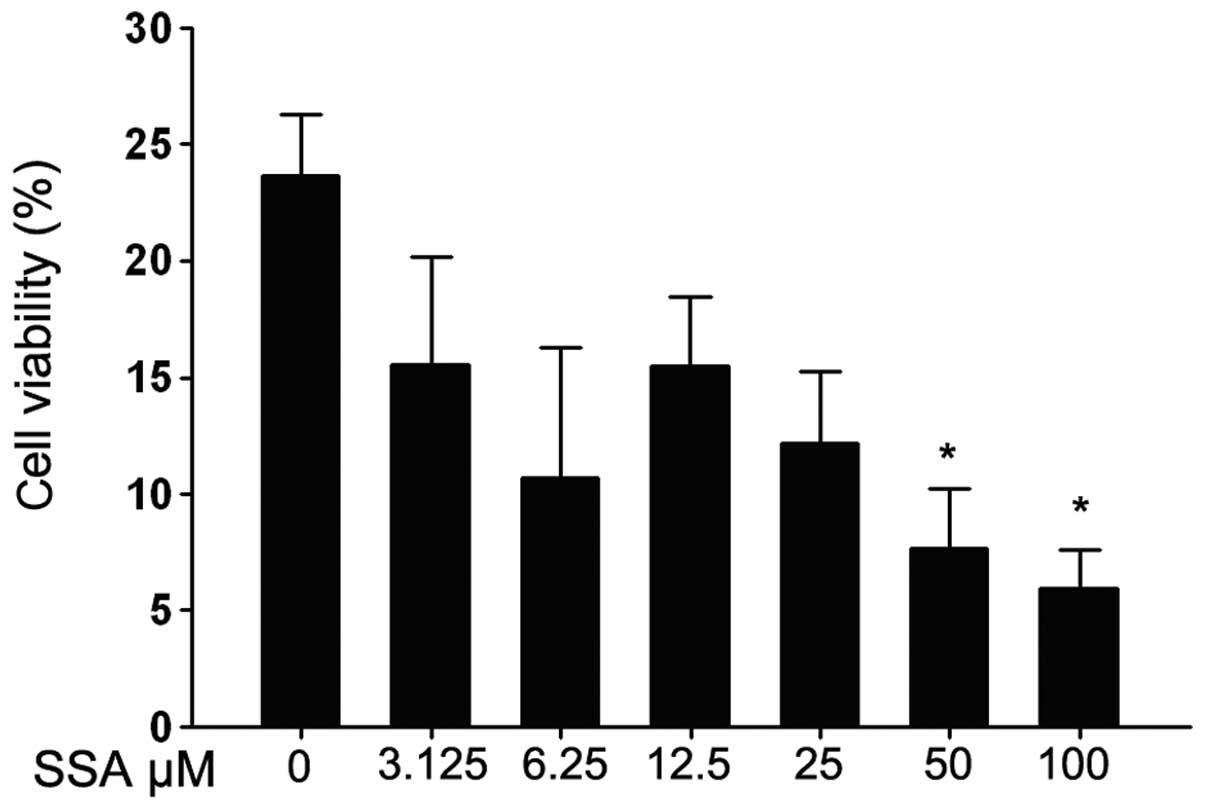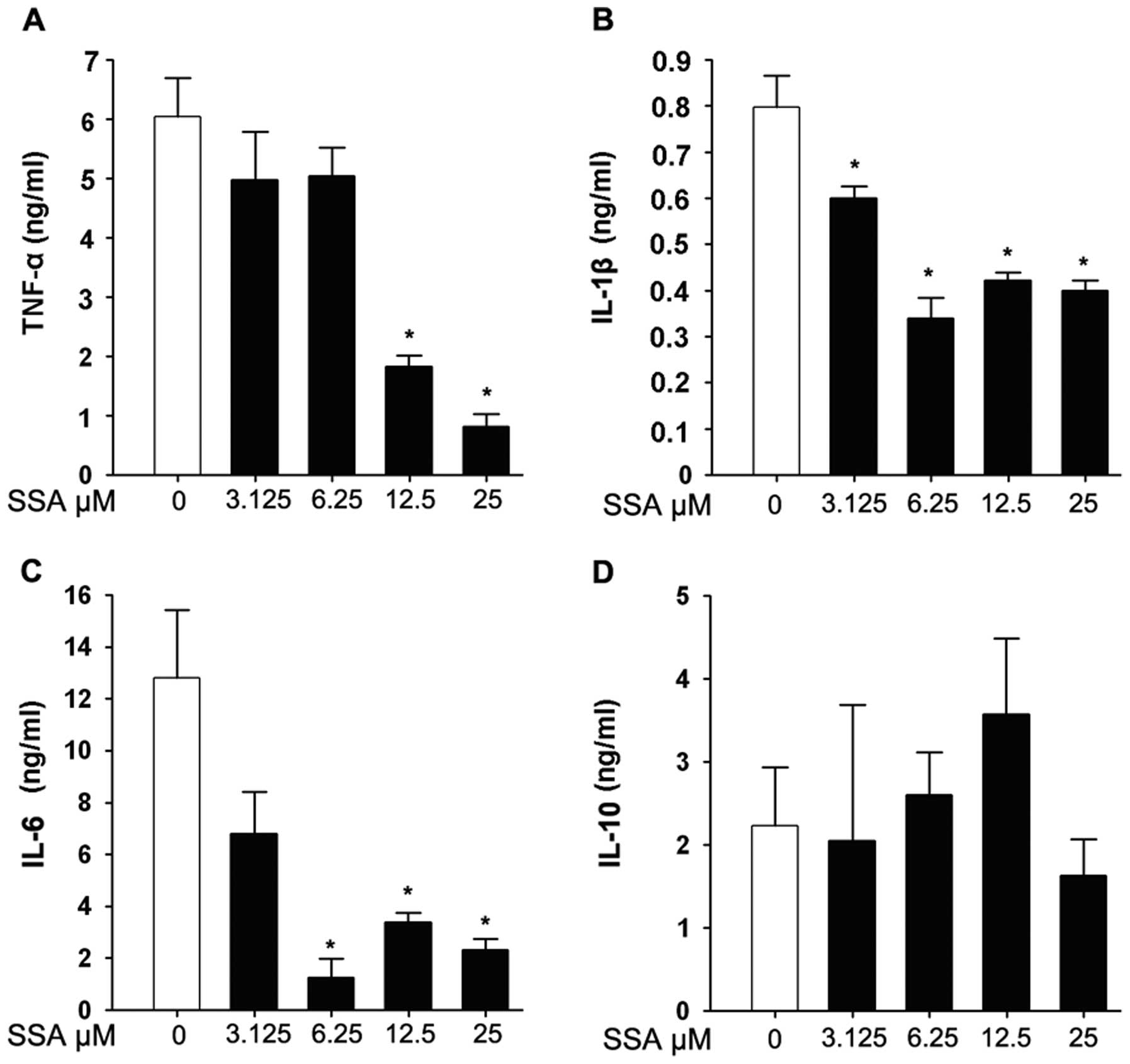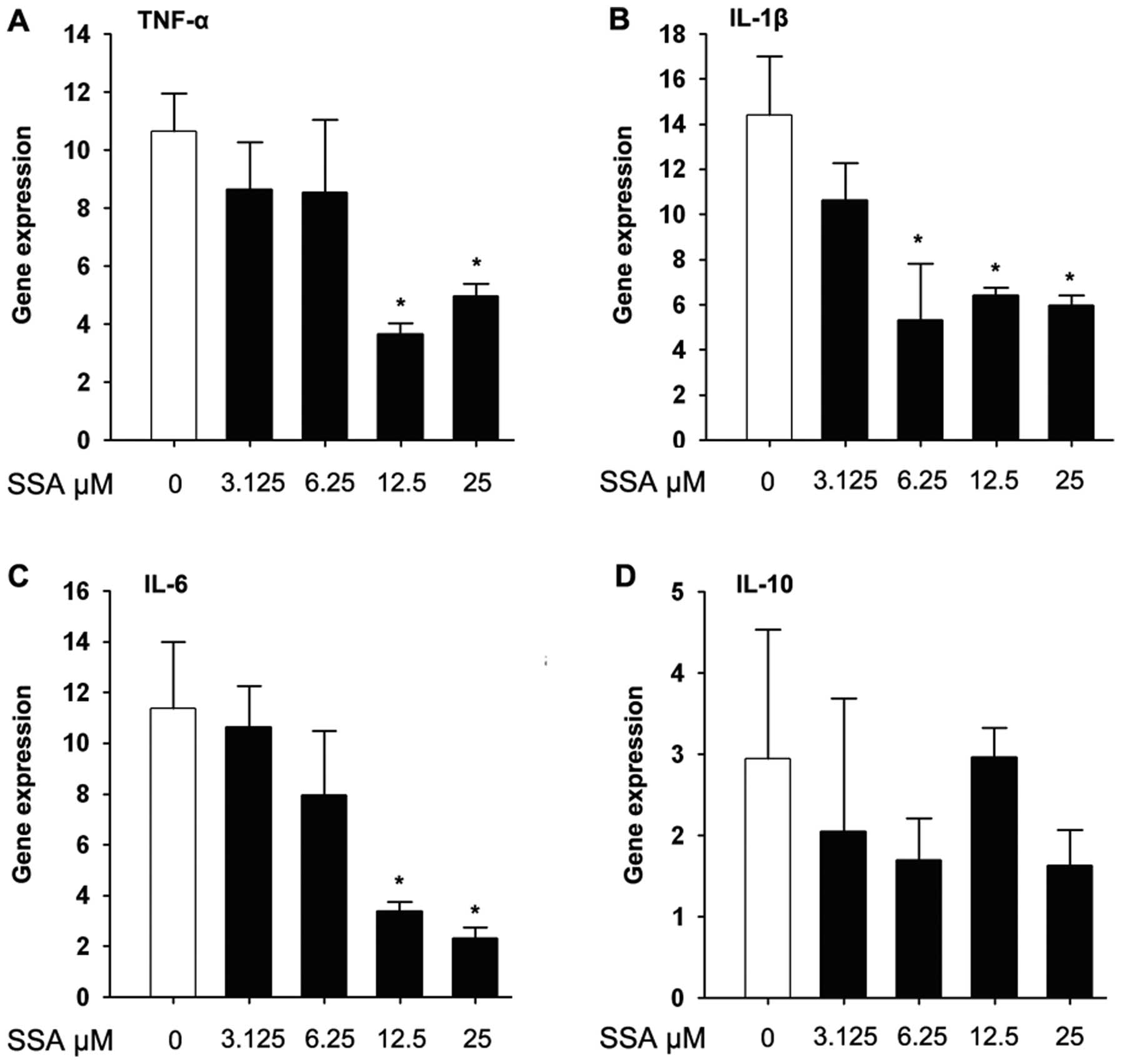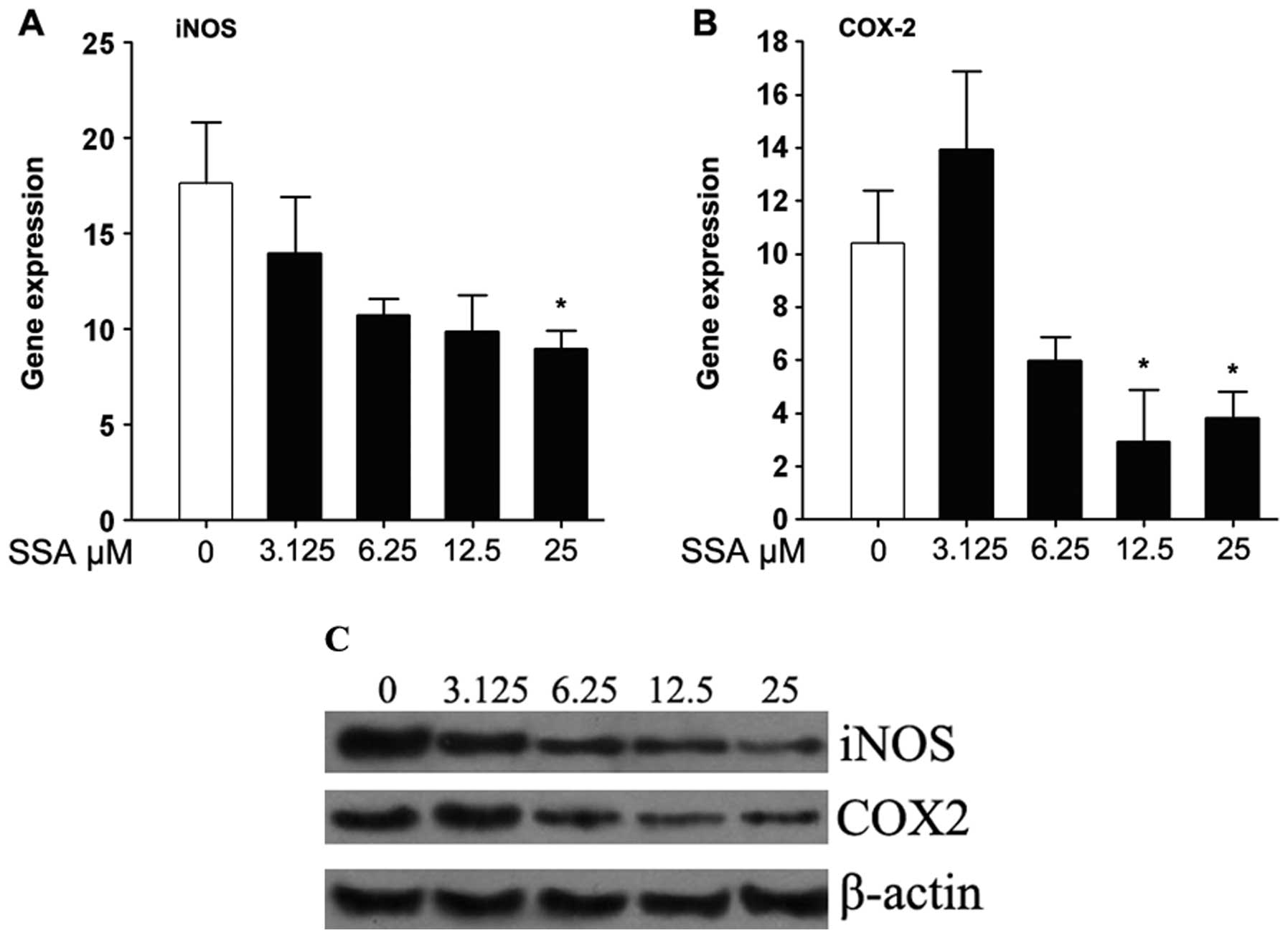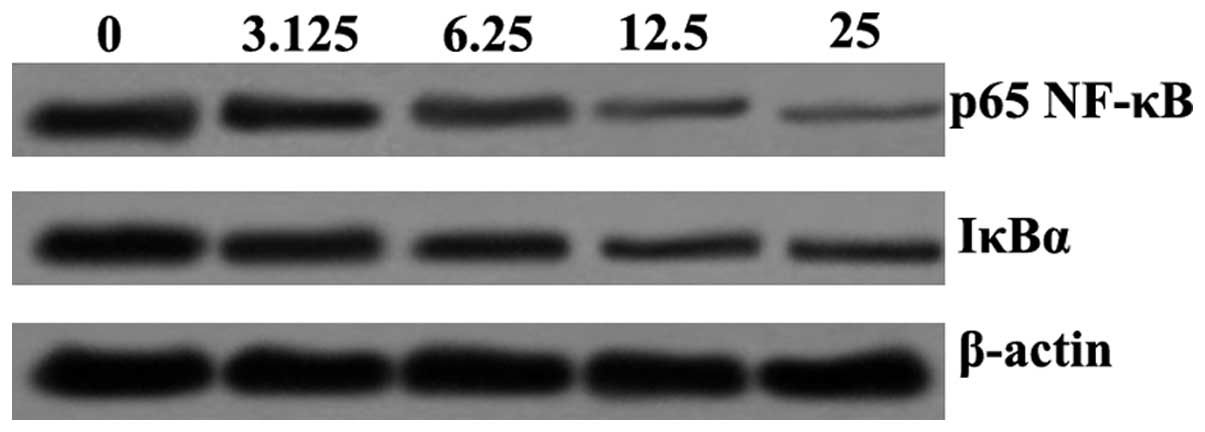Saikosaponin A mediates the inflammatory response by inhibiting the MAPK and NF-κB pathways in LPS-stimulated RAW 264.7 cells
- Authors:
- Published online on: March 4, 2013 https://doi.org/10.3892/etm.2013.988
- Pages: 1345-1350
Abstract
Introduction
Radix Bupleuri (RB), isolated from the dried roots of Bupleurum chinense DC or Bupleurum scorzonerifolium Willd, has been used as a health product and natural remedy for centuries in traditional Chinese medicine, based on its hepato-protective, antipyretic, analgesic, immunomodulatory and anti-inflammatory effects (1,2). As major bioactive compounds isolated from RB, saikosaponins have numerous biological activities, including immunoregulatory, anti-inflammatory, anti-bacterial and anti-viral activity (3,4). One study demonstrated that saikosaponin A (SSA) exhibits anti-inflammatory activity (5). However, the potential molecular mechanism of SSA in terms of the anti-inflammatory signaling pathways has not been fully determined.
Inflammation is a beneficial host response to foreign challenge or tissue injury, helping facilitate the restoration of tissue structure. However, prolonged inflammation is not beneficial as it contributes to the pathology of a number of diseases (6,7). Therefore, anti-inflammatory agents have potential therapeutic effects for various inflammation-related diseases. It is well established that activated immunocytes are involved in the inflammation process, particularly macrophages, which play a crucial role in the specific and non-specific immune responses during inflammation (8). Lipopolysaccharide (LPS) induces the release of inflammatory mediators in macrophages, leading to the production of inducible nitric oxide synthase (iNOS), tumor necrosis factor (TNF)-α, interleukin (IL)-1β and IL-6 (9,10).
Cytokines play essential roles in the inflammatory response, mainly due to their crucial effects on the differentiation, maturation and activation of cells (11). However, excessive production of cytokines harms organisms (6). It has been reported that patients suffering from inflammatory diseases present abnormalities in pro- and anti-inflammatory cytokines (12). Inflammatory cytokine release in response to LPS is mediated by the activation of nuclear factor κ-light-chain enhancer of activated B cells (NF-κB) and mitogen-activated protein kinase (MAPK) (13,14). NF-κB is a family of transcription factors and regulates the expression of a number of immune-related cytotoxic factors, including iNOS and cyclooxygenase-2 (COX-2), and pro-inflammatory cytokines, including TNF-α, IL-1β, IL-6 and IL-8 (15,16). The MAPK family also induces the production of immune-related cytotoxic factors and pro-inflammatory cytokines (17,18). Therefore, NF-κB and MAPKs are well-recognized as targets of anti-inflammatory agents.
In the present study, we examined the effects of SSA on the production of various inflammatory cytokines in LPS-stimulated mouse RAW 264.7 macrophages. We also investigated its anti-inflammatory mechanism, focusing on inflammatory signaling pathways. To our knowledge, this is the first report demonstrating that SSA inhibits the production of immune-related cytotoxic factors and inflammatory cytokines induced by LPS by inhibiting the NF-κB and MAPK signaling pathways.
Materials and methods
Reagents
SSA was purchased from Sichuan Victory Biotechnology Co., Ltd. (Sichuan, China), with 98% purity detected by high performance liquid chromatography (HPLC). LPS (Escherichia coli 026:B6), dimethyl sulfoxide (DMSO) and 3-[4,5-dimethylthiazol- 2-yl]-2,5-diphenyltetrazolium bromide (MTT) were purchased from Sigma (St. Louis, MO, USA). TNF-α, IL-1β, IL-6 and IL-10 enzyme-linked immunosorbent assay (ELISA) kits were purchased from R&D Systems (Minneapolis, MN, USA). Dulbecco’s modified Eagle’s medium (DMEM) and fetal bovine serum (FBS) were purchased from HyClone Laboratories of Thermo Scientific (Logan, UT, USA).
The antibodies, including iNOS, COX-2, NF-κB (p65) and β-actin were obtained from Cayman Chemical Co. (Ann Arbor, MI, USA). Antibodies for phospho-extracellular signal-regulated kinases (ERK)1/2, ERK, phospho-p38, p38, phospho-Jun N-terminal kinase (JNK), JNK, IκBα and p65 were obtained from Cell Signaling Technology (Danvers, MA, USA).
Cell culture and sample treatment
The mouse macrophage cell line RAW 264.7 was obtained from the Center of Cellular Resources, Central South University, Changsha, China. Cells were cultured in DMEM supplemented with 10% heat-inactivated FBS, 3 mM glutamine, 100 U/ml penicillin and 100 μg/ml streptomycin at 37°C under a humidified atmosphere of 5% CO2. In all experiments, cells were left to acclimate for 24 h before treatment. SSA was added 1 h prior to LPS (1 mg/l) treatment. The study was approved by the ethics committee of Central South University, Changsha, China.
MTT assay for cell viability
Cytotoxicity induced by SSA was analyzed by MTT assay. RAW 264.7 cells were plated at a density of 1×104 cells/ml onto 96-well plates containing 100 μl DMEM and incubated overnight. After acclimating for 24 h, the cells were treated with 100 μl SSA at various concentrations (3.125, 6.25, 12.5, 25, 50 and 100 μM) for 1 h, followed by stimulation with 50 μl LPS (1 mg/l) for 18 h. Subsequently, 20 μl MTT (5 mg/ml, 20 μl/well) in FBS-free medium was added to each well and further incubated for 4 h. Cell-free supernatants were then removed and cells were resolved with 150 μl DMSO per well, followed by optical density measurement at 490 nm with a ELX800-UV absorbance microplate reader (BioTek Instruments Inc., Winooski, VT, USA).
Cytokine determination
To determine the effects of SSA on cytokine release in LPS-stimulated cells, the production of TNF-α, IL-1β, IL-6 and IL-10 was measured by ELISA. RAW 264.7 cells were grown in a 6-well plate at a density of 3×105 cells/well for 24 h. The cells were pretreated with various concentrations of SSA compounds for 2 h and further challenged with LPS for an additional 18 h at 37°C with 5% CO2. The supernatants were then collected and centrifuged at 1,000 x g, 4°C for 10 min. The levels of TNF-α, IL-1β, IL-6 and IL-10 in the supernatants were determined using ELISA kits, according to the manufacturer’s instructions.
Real-time fluorescent quantitative polymerase chain reaction (PCR)
RAW 264.7 cells (4×105 cells/ml), cultured in 6-well plates for 24 h, were pretreated with various concentrations (3.125, 6.25 and 12.5 μM) of SSA for 2 h before treatment with 1 μg/ml LPS for 3 h in a 37°C, 5% CO2 incubator. Following two washes with ice-cold phosphate-buffered saline (PBS), the cells were harvested and total cellular RNA was isolated using the TRIzol reagent, according to the manufacturer’s instructions (Invitrogen Life Technologies, Carlsbad, CA, USA). For the real-time PCR, 1 μg total RNA was reverse-transcribed to synthesize cDNA using a first-strand cDNA synthesis kit (Takara, Dalian, China). Quantitative real-time PCR was performed on a Bio-Rad CFX 96 real-time PCR detection system in a 30 ml reaction volume containing iQ™ SYBR-Green Supermix (Bio-Rad, Hercules, CA, USA), 100 nM primers and 1 ml appropriately diluted cDNA template. The parameters of the PCR reaction were as follows: 94°C for 3 min for one cycle, then 94°C for 30 sec, 55–59°C for 30 sec, 72°C for 45 sec for 30 cycles and 72°C for 5 min for one cycle. The relative gene expression was calculated by the comparative Ct method (2−ΔΔCt), using glyceraldehyde 3-phosphate dehydrogenase (GAPDH) as the house keeping gene. The primer sequences for analysis of TNF-α, IL-1β, IL-6 and GAPDH mRNA are presented in Table I.
Western blot analysis
Western blot analysis was performed to evaluate the effect of the test compound on iNOS, COX-2, NF-κB (p65) and inhibitory NF-κB inhibitor α (IκBα) in the cytosol and nucleus, as well as the expressions of P38 MAPK, c-JNK and ERK. The RAW 264.7 cells were cultivated in a 6-well plate for 24 h and then received appropriate treatment with SSA in the absence or presence of LPS for 2 h. After treatment for 18 h with LPS, the cells were harvested and the total protein, cytosol protein and nuclear protein were extracted using a Nuclear-Cytosol Extraction Kit (Cell Signaling Technology). β-actin was used as the control. The protein was separated on polyacrylamide gels and then transferred onto a polyvinylidene fluoride (PVDF) membrane. The membranes were blocked and incubated with different antibodies, followed by incubation with the horseradish peroxidase (HRP)-linked secondary antibody. The signals were detected using an enhanced chemiluminescence (ECL) reagent (Bio-Rad). The images were quantified by Bio-Rad Quantity One software. The quantities of the target bands were normalized by β-actin.
Statistical analysis
Data, expressed as means ± standard deviation, were analyzed by one-way analysis of variance (ANOVA). Significant differences were determined with Tukey’s multiple range tests. All tests were performed using SPSS 13.0 software (SPSS Inc., Chicago, IL, USA). P<0.05 was considered to indicate a statistically significant difference.
Results
Cytotoxicity of SSA on RAW 264.7 cells
Prior to evaluating the anti-inflammatory activity of SSA, the cytotoxic effect of SSA on RAW 264.7 cells was tested using the MTT assay. As shown in Fig. 1, cell viability was significantly reduced with 12.5–100 μM SSA, while 3.125 and 6.25 μM SSA had no effect on LPS-stimulated RAW 264.7 cells.
SSA inhibits the release of LPS-induced pro-inflammatory cytokines in RAW 264.7 cells
TNF-α, IL-1β, IL-6 and IL-10 concentrations in the culture supernatants of RAW 264.7 cells were evaluated by ELISA. As shown in Fig. 2A, TNF-α was significantly inhibited by pretreatment with SSA in a dose-dependent manner. A similar tendency was also observed in IL-6 and IL-1β production at various concentrations of SSA (Fig. 2B and C). However, SSA pretreatment had no significant effect on IL-10 compared to the control group in this assay (Fig. 2D).
SSA inhibits the mRNA level of TNF-α, IL-1β, IL-6 and IL-10 in LPS-stimulated RAW 264.7 cells
Real-time PCR was employed to quantitate TNF-α, IL-6, IL-1β and IL-10 gene expression from cDNA samples. For the mRNA expression of pro-inflammatory cytokines, SSA pretreatment for 1 h significantly inhibited the expression of TNF-α, IL-1β and IL-6 compared to the control group, and upregulated the expression of IL-10 (Fig. 3).
SSA suppresses the expression of iNOS and COX-2 in LPS-stimulated RAW 264.7 cells
Real-time PCR and western blotting were performed to determine the inhibitory effect of SSA on the mRNA and protein levels of iNOS and COX-2, respectively. As shown in Fig. 4A and B, the mRNA expressions of iNOS and COX-2 were reduced in a dose-dependent manner by SSA in LPS-stimulated RAW 264.7 cells. Also, SSA strongly downregulated iNOS and COX-2 protein expression (Fig. 4C).
SSA suppresses the LPS-induced activation of NF-κB signaling in RAW 264.7 cells
Western blotting was performed to determine the effect of SSA on LPS-induced NF-κB activation. The results revealed that p65 NF-κB and IκBα protein expression were downregulated by SSA. The p65 NF-κB and IκBα protein expression demonstrated a dose-dependent effect on suppression induced by SSA (Fig. 5).
SSA suppresses the LPS-induced activation of MAPK signaling in RAW 264.7 cells
In order to understand the mechanism by which SSA inhibits LPS-induced production of inflammatory cytokines, we detected the possible connection between SSA and the MAPK pathway. Following SSA treatment, the phosphorylation of p38 MAPK and c-JNK had markedly decreased compared to the control in a dose-dependent manner (Fig. 6).
Discussion
Macrophages play a crucial role in the specific and non-specific immune responses during the inflammatory process by producing a large amount of inflammatory mediators, including immune-related cytotoxic factors and inflammatory cytokines. Despite the beneficial effect during infection, excessive production of inflammatory mediators may cause edema, cellular metabolic stress and tissue necrosis (12). As a result, agents regulating inflammatory cytokines may have therapeutic effects. The present study demonstrated that LPS effectively induces the activation of macrophages, which is consistent with previous reports (19,20). By activating several signals and transcription factors, including MAPKs and NF-κB, LPS induces the activation of inflammatory cytokines in macrophages, leading to the production of TNF-α, IL-6, IL-1β and IL-10 (9,10). In the present study, we demonstrated that SSA markedly inhibits immune-related cytotoxic factors, including iNOS and COX-2, and pro-inflammatory cytokines, including TNF-α, IL-1β and IL-6. It also increased the protein and mRNA levels of the anti-inflammatory cytokine, IL-10, in LPS-stimulated RAW 264.7 macrophages. These data demonstrate the anti-inflammatory activity of SSA in macrophages stimulated by LPS.
To further clarify the molecular mechanism of the inhibitory effect of SSA on inflammatory mediators, we investigated the effects of SSA on the activation of two signaling pathways, NF-κB and MAPKs, in LPS-stimulated macrophages. LPS has been shown to induce the NF-κB signaling pathway in macrophages (21). NF-κB, a family of transcription factors, is universally expressed in various types of cells and regulates the transcription of a number of key inflammatory mediators, including COX-2, TNF-α, IL-1β, IL-6 and IL-10 (22). Therefore, the NF-κB signaling pathway acts as a core regulator of inflammation. Under normal conditions, NF-κB associates with IκBs, which sequester NF-κB in the cytoplasm. The activation of NF-κB begins with the phosphorylation of IκBα. Then, the phosphorylation of IκBα allows itself to be ubiquitinated and eventually degraded by the 26S proteasome (23). Once IκBα is degraded, the nuclear localization signal of NF-κB is not masked and NF-κB is able to translocate to the nucleus and promote the transcription of target genes (24). As demonstrated in the present study, in the control group, the phosphorylation levels of IκBα and p65 NF-κB were high following exposure to LPS; however, following administration of SSA, the phosphorylation of p65 NF-κB and IκBα were markedly decreased in a dose-dependent manner. These data indicate that SSA blocks the NF-κB signaling pathway by inhibiting the phosphorylation of IκBα, preventing NF-κB translocation to the nucleus.
The other major extracellular signaling pathway induced by inflammatory mediators is the MAPK pathway. In the MAPK family, p38 MAPK, c-JNK and ERKs are the most important components (18). LPS has been shown to induce the MAPK signaling pathway in macrophages (25), which is consistent with our data. In the present study, we identified that phosphorylation of p38 MAPK and c-JNK was high in LPS-stimulated macrophages; however, following administration of SSA, the phosphorylation of p38 MAPK and c-JNK significantly reduced in a dose-dependent manner, suggesting that the activation of the MAPK signaling pathway is inhibited by SSA. Since it is well established that MAPKs regulate various inflammatory mediators, including TNF, IL-1, IL-2, IL-6 COX-2 and iNOS (26–28), we consider that the anti-inflammatory activity of SSA is associated with its inhibitory effect on the MAPK signaling pathway.
In conclusion, this study demonstrated that SSA has an inhibitory effect on pro-inflammatory cytokines, as well as a facilitative effect on anti-inflammatory cytokines in LPS-stimulated macrophages. The mechanism of these actions involves the regulation of MAPK and NF-κB signals.
References
|
Ashour ML and Wink M: Genus Bupleurum: a review of its phytochemistry, pharmacology and modes of action. J Pharm Pharmacol. 63:305–321. 2011. View Article : Google Scholar | |
|
Kong XY, Hao Y, Wu TX and Xie YM: Adverse drug reactions or adverse events of Chaihu Injection: a systematic review. Zhong Xi Yi Jie He Xue Bao. 8:1124–1132. 2010.(In Chinese). | |
|
Wu GC, Wu H, Fan LY and Pan HF: Saikosaponins: a potential treatment option for systemic lupus erythematosus. Ir J Med Sci. 180:259–261. 2011. View Article : Google Scholar : PubMed/NCBI | |
|
Sui C, Zhang J, Wei J, et al: Transcriptome analysis of Bupleurum chinense focusing on genes involved in the biosynthesis of saikosaponins. BMC Genomics. 12:5392011.PubMed/NCBI | |
|
Lu CN, Yuan ZG, Zhang XL, et al: Saikosaponin a and its epimer saikosaponin d exhibit anti-inflammatory activity by suppressing activation of NF-kappaB signaling pathway. Int Immunopharmacol. 14:121–126. 2012. View Article : Google Scholar : PubMed/NCBI | |
|
Philippou A, Maridaki M, Theos A and Koutsilieris M: Cytokines in muscle damage. Adv Clin Chem. 58:49–87. 2012. View Article : Google Scholar | |
|
Lee IT and Yang CM: Role of NADPH oxidase/ROS in pro-inflammatory mediators-induced airway and pulmonary diseases. Biochem Pharmacol. 84:581–590. 2012. View Article : Google Scholar : PubMed/NCBI | |
|
Romeo GR, Lee J and Shoelson SE: Metabolic syndrome, insulin resistance and roles of inflammation - mechanisms and therapeutic targets. Arterioscler Thromb Vasc Biol. 32:1771–1776. 2012. View Article : Google Scholar : PubMed/NCBI | |
|
Wang Y, Yu C, Pan Y, et al: A novel compound C12 inhibits inflammatory cytokine production and protects from inflammatory injury in vivo. PLoS One. 6:e243772011. View Article : Google Scholar : PubMed/NCBI | |
|
Borges MC, Vinolo MA, Crisma AR, et al: High-fat diet blunts activation of the nuclear factor-kappaB signaling pathway in lipopolysaccharide-stimulated peritoneal macrophages of Wistar rats. Nutrition. Oct 19–2012.(Epub ahead of print). | |
|
Paulsen G, Mikkelsen UR, Raastad T and Peake JM: Leucocytes, cytokines and satellite cells: what role do they play in muscle damage and regeneration following eccentric exercise? Exerc Immunol Rev. 18:42–97. 2012.PubMed/NCBI | |
|
Ren G, Zhao X, Zhang L, et al: Inflammatory cytokine-induced intercellular adhesion molecule-1 and vascular cell adhesion molecule-1 in mesenchymal stem cells are critical for immunosuppression. J Immunol. 184:2321–2328. 2010. View Article : Google Scholar : PubMed/NCBI | |
|
Wu YH, Chuang SY, Hong WC, Lai YJ, Chang GJ and Pang JH: Berberine reduces leukocyte adhesion to LPS-stimulated endothelial cells and VCAM-1 expression both in vivo and in vitro. Int J Immunopathol Pharmacol. 25:741–750. 2012.PubMed/NCBI | |
|
Shao J, Liu T, Xie QR, et al: Adjudin attenuates lipopolysaccharide (LPS)- and ischemia-induced microglial activation. J Neuroimmunol. 254:83–90. 2012. View Article : Google Scholar : PubMed/NCBI | |
|
Sohn KH, Jo MJ, Cho WJ, et al: Bojesodok-eum, a herbal prescription, ameliorates acute inflammation in association with the inhibition of NF-kappaB-mediated nitric oxide and proinflammatory cytokine production. Evid Based Complement Alternat Med. 2012 Oct 8–2012.(Epub ahead of print). | |
|
Cortez M, Carmo LS, Rogero MM, Borelli P and Fock RA: A high-fat diet increases IL-1, IL-6 and TNF-alpha production by increasing NF-kappaB and attenuating PPAR-gamma expression in bone marrow mesenchymal stem cells. Inflammation. Oct 19–2012.(Epub ahead of print). | |
|
Xie GC and Duan ZJ: Signal transduction of innate immunity to virus infection. Bing Du Xue Bao. 28:303–310. 2012.(In Chinese). | |
|
Kyriakis JM and Avruch J: Mammalian MAPK signal transduction pathways activated by stress and inflammation: a 10-year update. Physiol Rev. 92:689–737. 2012.PubMed/NCBI | |
|
Gyorfy Z, Duda E and Vizler C: Interactions between LPS moieties and macrophage pattern recognition receptors. Vet Immunol Immunopathol. Sep 26–2012.(Epub ahead of print). | |
|
Liu Z, Li W, Wang F, et al: Enhancement of lipopolysaccharide-induced nitric oxide and interleukin-6 production by PEGylated gold nanoparticles in RAW264.7 cells. Nanoscale. Oct 16–2012.(Epub ahead of print). | |
|
Tacchi L, Casadei E, Bickerdike R, Secombes CJ and Martin SA: MULAN related gene (MRG): A potential novel ubiquitin ligase activator of NF-kB involved in immune response in Atlantic salmon (Salmo salar). Dev Comp Immunol. 38:545–553. 2012. View Article : Google Scholar : PubMed/NCBI | |
|
DiDonato JA, Mercurio F and Karin M: NF-kappaB and the link between inflammation and cancer. Immunol Rev. 246:379–400. 2012. View Article : Google Scholar : PubMed/NCBI | |
|
Iwai K: Diverse ubiquitin signaling in NF-kappaB activation. Trends Cell Biol. 22:355–364. 2012. View Article : Google Scholar : PubMed/NCBI | |
|
Dyson HJ and Komives EA: Role of disorder in IkappaB-NFkappaB interaction. IUBMB Life. 64:499–505. 2012. View Article : Google Scholar | |
|
Tang X and Zhu Y: TLR4 signaling promotes immune escape of human colon cancer cells by inducing immunosuppressive cytokines and apoptosis resistance. Oncol Res. 20:15–24. 2012. View Article : Google Scholar : PubMed/NCBI | |
|
Wang Z, Jiang W, Zhang Z, Qian M and Du B: Nitidine chloride inhibits LPS-induced inflammatory cytokines production via MAPK and NF-kappaB pathway in RAW 264.7 cells. J Ethnopharmacol. 144:145–150. 2012. View Article : Google Scholar : PubMed/NCBI | |
|
Cheng W, Chen L, Yang S, et al: Puerarin suppresses proliferation of endometriotic stromal cells partly via the MAPK signaling pathway induced by 17ss-estradiol-BSA. PLoS One. 7:e455292012. View Article : Google Scholar : PubMed/NCBI | |
|
Ihara H, Yamamoto H, Ida T, et al: Inhibition of nitric oxide production and inducible nitric oxide synthase expression by a polymethoxyflavone from young fruits of Citrus unshiu in rat primary astrocytes. Biosci Biotechnol Biochem. 76:1843–1848. 2012. View Article : Google Scholar : PubMed/NCBI |



